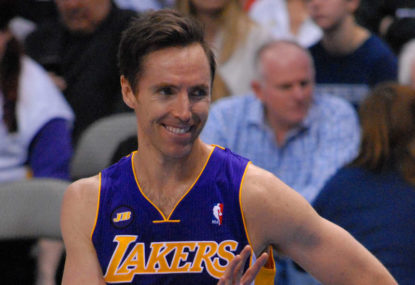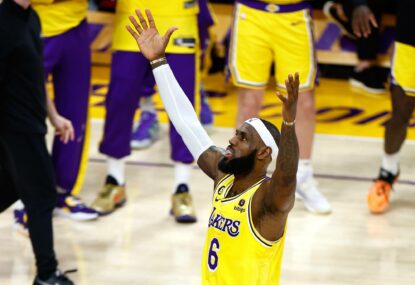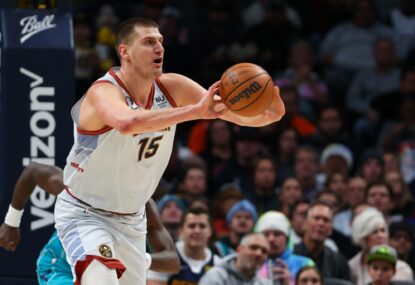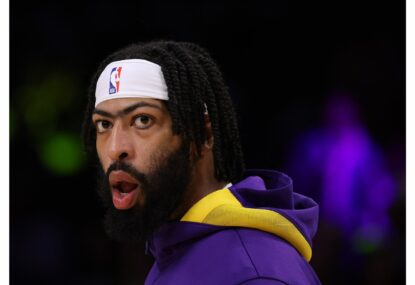Kevin Durant, Blake Griffin, Dirk Nowitzki, Kobe Bryant and LeBron James. These guys are only the same species that we are by the loosest of definitions.
Of all the basketball superstars of the past 15 years, Steve Nash is the easiest to relate to.
Unlike LeBron and Durant, Nash doesn’t succeed due to freakish height, Olympian quickness or comic book-type leaping ability.
He’s a 6’3″, 81-kilogram white dude from Vancouver who occasionally flaunts pretty bad long hair.
Nash’s multitude of talents – coordination, timing, work ethic, vision, leadership and teamwork – are common talents that many of us possess, he just fine-tuned them over the course of his career to a level of eery perfection.
Due to his athletic deficiency in respect to his peers, Nash had to maximise his expertise of concepts like nutrition, fitness and sleeping patterns to maintain an edge on the competition. In many ways Nash represents the best possible athletic representation of the layman.
He’s our representative, our elected official to a foreign world of freakish athleticism.
Barring a miracle, Steve Nash has played his last game in the NBA. After playing only 65 of a possible 164 games the past two seasons due to recurring nerve damage, Nash has been ruled out for the entirety of the 2014-15 season because of the same injury.
This is the last year on his contract and by the time next season starts he’ll be four months away from being 42 years old. It’s over, and in many ways that’s a relief, for Nash I’m sure, but for us, his reverent audience, as well.
Watching Nash’s body and game deteriorate over the past two years has been nearly as depressing as his earlier success was uplifting. He went from looking like the best possible imagined version of me on the basketball court to just looking like me on the basketball court. It was no fun watching a slew of younger and more explosive athletes pick Nash’s 40-year-old pockets for cheap steals in the backcourt.
It didn’t just feel unfair, it felt cruel. So while his latest injury is in many ways brutal and devastating for Nash and basketball fans, it’s also unquestionably merciful.
It’s staggering how quickly an NBA player can go from All-Star to out of the league. Gilbert Arenas, Tracy McGrady, Baron Davis, Allen Iverson… the list goes on. Nash is seemingly the next name up on this list; an All-Star in 2012, out of the league in 2014.
There is, however, one important caveat to note with Nash. While Arenas was only 30 when he played his last All-Star game, Steve Nash was 40. So although the end for Nash may appear to have come suddenly, in reality the end has come ridiculously slowly. In 2004 the Mavericks decided not to re-sign Nash because they thought that he was too old. He played for another 10 years, winning two MVPs and making six All-Star teams in the process.
Ultimately, Nash’s legacy will be that he revolutionised NBA offence, with his mastery of the pick and roll completely changing the way teams thought about putting the ball into the hoop. Before Nash’s Suns, the league was individual obsessed, with teams hell-bent on playing Jordan-ball and having elite individual talents like Bryant, Iverson, Wade, Arenas and McGrady play one on five hero ball while their teammates stood and watched.
The problem, shockingly, was that none of those guys were Michael Jordan, and the result was ugly, selfish basketball where superstars shot 11 for 29 every other night (note: if anyone pines for these days of hero ball, check out this year’s Lakers, because I’m pretty sure Kobe just bricked another two contested mid-range jumpers while I typed this sentence).
Nash’s Suns were the dominant offence in the league for more than half a decade, scoring at a rate that only Jordan’s Bulls, Larry Bird’s Celtics and Magic Johnson’s Lakers matched. The rest of the league had to catch up, and Nash’s selflessness and creativity drove the Suns and the league towards aesthetically pleasing, spread-out, move the ball, launch threes and get everyone involved team offence.
The two best teams of the past half-decade, LeBron’s Heat and Gregg Popovich’s Spurs, two majestically team-oriented free movers of the ball, would not exist as they did (or continue to, in the case of the Spurs) without Steve Nash.
My resounding memory of Nash will always be the fourth quarter of Game 5 of the 2010 conference finals against the Lakers. Effectively the decisive game of the series, with Nash’s Suns down against Kobe’s much more talented Lakers, Nash took over the game in the last four minutes.
With the Lakers switching everything on the pick and roll and leaving Pau Gasol to guard him, Nash calmly hit four consecutive in rhythm mid-range jump-shots to keep the game alive. The game epitomised Nash as a basketball player; his intangibles, his fearlessness and leadership to take and make big shots. His unprecedented ability to make brute strength, explosiveness and unreasonable height vulnerable to timing, finesse and vision was on full display that night.
Sadly, that Game 5 against the Lakers was also symbolic of Nash’s career because his team eventually lost despite his efforts. Few athletes deserve a title as much as Nash and the fact that he never got one only heightens how sympathetic a character he is. Failure is inevitably more relatable than success.
While Nash’s time with the Lakers was largely devoid of the sporting heroism that he showed that night in Los Angeles, he did however occasionally show flashes of his former self in purple and gold. He delivered one such flash in early February this year against the 76ers with a wind-the-clock-back 19 points and five assists, schooling Evan Turner with a nifty behind the back crossover in the process.
It was a reminder of what made Nash so great, his ability at 40 years old to use simple misdirection to get the better of Turner, the prototype of the modern NBA guard at 6’7″ with crazy length. The success of such a simple move by a broken down old dude against an athlete like Turner was also a comforting reminder that these guys aren’t superheroes; they’re human beings like the rest of us.


































































































